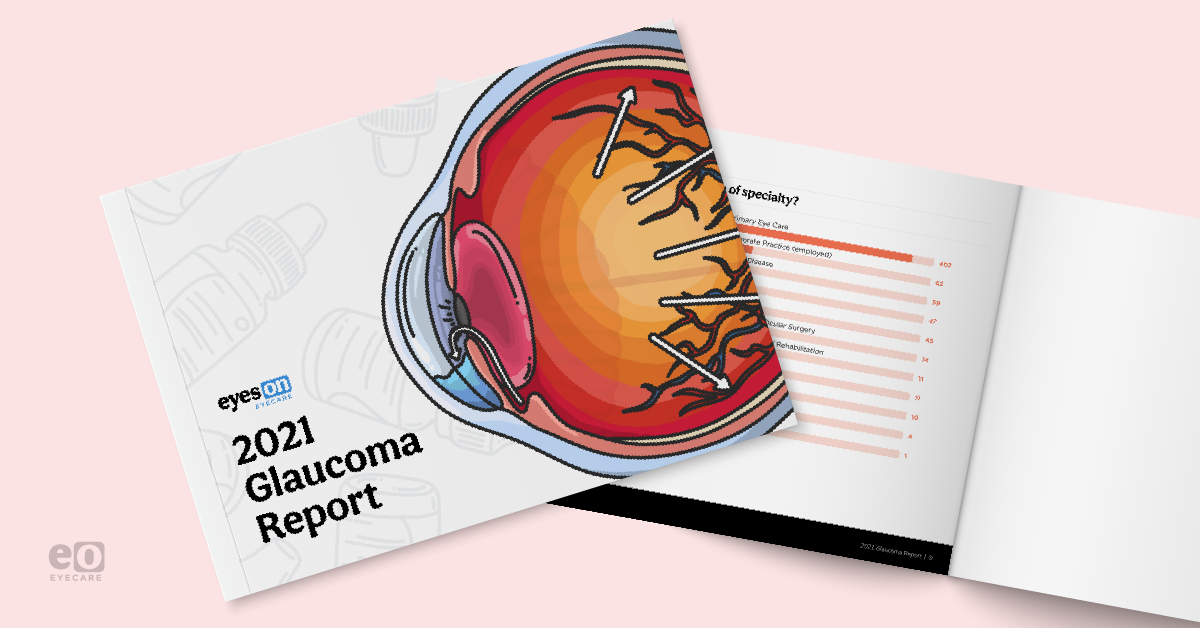As practitioners on the front lines of glaucoma care, optometrists play a vital role in treating and managing this condition. The average OD refers out 40% of their glaucoma patients to ophthalmologists, making it more important than ever for ophthalmologists to understand how their eyecare colleagues are approaching glaucoma diagnosis, treatment, and management.
In May 2021, Eyes On Eyecare surveyed 667 optometrists to learn more about how they approach glaucoma in their practices. The result is the 2021 Glaucoma Report—and, as with all Eyes On Eyecare reports, this exclusive data is absolutely free to download! Read the report for a look at optometrists’ favored front-line treatments, co-management strategies, and overall confidence in treating this condition.
Download the 2021 Glaucoma Report now or keep reading for a sneak peek at the findings!
📚
Download the 2021 Glaucoma Report
Get free access to over 20 pages of data!
The 2021 Glaucoma Report covers:
- Glaucoma prevalence among patient populations: How many of your patients have been diagnosed with glaucoma?
- Referrals and co-management: How do optometrists rank their current referral and co-management process? What percentage of patients are referred out to ophthalmologists or other optometrists?
- Average confidence in diagnosing glaucoma: How comfortable are optometrists diagnosing glaucoma patients?
- Go-to front-line treatments for glaucoma: What are the top treatments prescribed by optometrists? How do they differ from the treatments optometrists would choose for themselves?
- Patient compliance: What percentage of patients are fully compliant with topical treatments?
- And more!
Optometrists are confident in glaucoma diagnosis, even if they don’t treat
Respondents estimated that 18% of their patients had been diagnosed with glaucoma—a number that only emphasizes how important eyecare has become for the aging US population.
Confidence in diagnosing and treating glaucoma was high (averaging over 7 out of 10 for both diagnosis and treatment), and optometrists ranked the quality of glaucoma education they receive in optometry school at an average of 7.19 out of 10.
The vast majority (85%) of optometrists cite topical medications as their go-to, front-line treatment for
primary open angle glaucoma. Latanoprost and Lumigan were among the most popular topical medications.
Most interestingly, while the vast majority of optometrists cite
topical medications as their go-to, front-line treatment for primary open angle glaucoma, only 50% would prefer topical medications as their primary treatment if they were diagnosed with glaucoma. We found 33% prefer SLT—suggesting that optometrists in many states likely prefer to refer their patients to ophthalmology practices for treatment.
Building relationships with co-management and referrals
When it comes to referrals and co-management of glaucoma, it’s interesting to see optometrists rate the quality of the co-management process for glaucoma patients within their practice at a 6.87 out of 10, a number that isn’t terrible but can certainly be improved.
On average, optometrists refer out 40% of their glaucoma patients to an ophthalmologist, largely because they believe the patient would benefit from a surgical procedure. We’re hopeful that the co-management processes and relationships between ophthalmologists and optometrists will continue to grow stronger through collaboration. After all, the ultimate goal of any disease treatment plan is to improve patient outcomes and quality of life.
